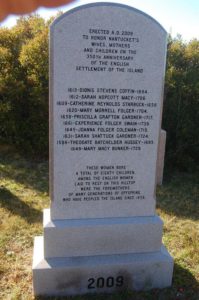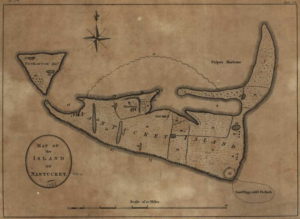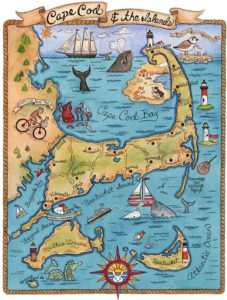 Edward Starbuck
Edward Starbuck
Edward, our 9th great grandfather, came with Thomas Macy, and James Coffin, in a small boat from Salsibury, England in 1635 during the early settlement of the Massachusetts Bay Colonies and was among the founding fathers of Nantucket Island.
Born in 16 Feb 1604 in Leicester, Derbyshire, England, the son of Edward and Ann Starbuck, he was a young man when he set sail with other men for the new world landing on the shores of New Hampshire with his wife Katherine Eunice Reynolds of Wales, daughter of Robert.
STARBUCK THE NAME
They settled in Dover, New Hampshire which was probably still Massachusetts at that time and it was he that brought the surname Starbuck to the United States. . This rare name is locational and derives from the Village of Starbeck, near Harrogate in Yorkshire, originally spelled ‘Starbok’. This original spelling which appears in the 1086 Domesday Book, indicates a Norse-Viking pre 9th Century origin ‘Stor-Bokki’, literally ‘Great River’. The name “Starbuck” is of Scandinavian decent and it’s possible that the family was of Danish origin that settled in England during the Viking invasions.
 THE BEGINNINGS
THE BEGINNINGS
Edward is first found in the records as receiving a land grant in 1643 for 40 acres of land on each side of the Eresh River at Cutchechoe, and a platt of Marsh above Cutchechoe where the brook runs out of the river, discovered by Richard Walderne, Edward Colcord,, Edward Starbuck, and William Furber. This definitely suggest that he was a man of exploration and adventure,
From 1643 to 1650 there are records of his many other grants of land.
In 1643, he was chosen as the first Representative from Dover to the General Court of the Massachusetts Bay Colony, and served again in 1647. (This was before New Hampshire existed as a separate colony.)
He and two others were appointed “wearesmen” or official river fishermen for Dover for life and were required to supple the town and the church from their catch.
In 1647 and 1650 he was granted the right to erect a sawmill and went into the timber business with Rich Waldron, and in 1652 he was granted the right to the use of certain lands.
He sold half of his timber and water rights to Peter Coffin who was his son in law, in 1653.
Edward served on a six man committee to settle a boundary dispute between Dover and Kitter in 1654, and was one of the commoners chosen to lay out the boundary between the towns.
Edward was prosecuted for taking on Baptist beliefs and pronouncing the concept that baptism should not take place until a child was old enough to decide for themselves. His religious views were disturbing to the colony, though he was a Quaker his religious views were not acceptable to his fellow townsmen.
In ” Provincial Papers of New Hampsbire,” we find the following:
” Oct. 18, 1648. — The Court being informed of great misdemeanor Committed by Edward Starbuck of Dover with profession of Anabaptism for which he is to be proceeded against at the next Court of Assistants if evidence can be prepared by that time & it being very farre for witnesses to travill to Boston at that season of the year, It is therefore ordered by this Court that the Secretary shall give Commission to Capt. Thomas Wiggan & Mr Edw. Smyth to send for such persons as they shall have notice of which are able to testify in the sd. cause & to take their testimony uppon oath & certifie the same to the secretary so soon as may be, that further proceedings may be therein, if the cause shall so require.”
As a result he was heavily fined. There was no separation for church and state then and the puritans who ran the colony were intolerant of people like the Anabaptists.
In 1658 the Congregational minister swore out a peace bod against him due to his religious beliefs. His last official duty in Dover was serving on a coroner’s jury that investigated the accidental death of a man on Nov. 11, 1659.
REMOVAL TO NANTUCKET
Edward could have possibly lived quite comfortably in Dover had it not been for the religious conditions of the colonies. The strong persecution of religious beliefs was most likely the reason that Edward decided to go to Nantucket. At the age of 55, Edward, James Coffin and Isaac Coleman arrived on Nantucket Island with Thomas Macy and stayed throughout the winter. They returned to Massachusetts the next spring, and returned in 1660 with his wife and children, except for daughters Sarah and Abigail, and ten other families. More settlers arrived the following year. Sarah who had married
The white settlers found Nantucket inhabited by about 1600 Wampanoag Indians who were farmers and fisherman and hunters. The arrival of the white man brought disease, alcohol, and debt servitude to the island which cause a cruel toll on the peaceful people over the next 100 years. By 1763 only 358 Indians survived and that number was reduced later that year when more than 222 died of the plague.
It is not to be wondered at that Edward Starbuck was quite ready to leave Dover under existing conditions. He was fifty-five years of age when he joined Thomas Macy in his voyage from Salisbury to Nantucket; he spent the winter there and in the spring returned to Dover for his family, who accompanied him to the island excepting his daughters Sarah (Aus- tin) and Abigail (Coffin), who had married and settled in Dover.
” Dover lost a good citizen ” and Nantucket gained a much respected one ; ” he was a leading man on the Island and at one time a Magistrate; ” he is described as ” courageous and persevering.”
 EDWARD THE PEACE KEEPER
EDWARD THE PEACE KEEPER
Edward had great repose among the Indians and was often called upon to settle disputes that came up with the natives in Dover and Nantucket. A deed of land to him from the Indians in 1660 is the oldest original Nantucket document in existence and his name appears on many other documents until his death.
During the 35 years of his life on the Island of Nantucket he was Representative in the General court, and Elder in the Church, and in 1669 he and Peter Coffin were appointed by the town meeting to manage the government among the Indians. Four year later He was chosen one of the town’s five selectmen, was one of the highest ranking government officers.
As a clergyman it is said that Edward was the one that read from the Bible at the funeral of his dear friend Tristram Coffin.
Edward was instrumental in the development of the land and began the development of the whaling company.
It is said that at the time of his death he was the wealthiest man in Nantucket owning a third of the Island in land. He left most of his property to his only living son Nathaniel, as was the tradition at that time.

Nathaniel and Mary Starbuck
Nathaniel went with his father to Nantucket and married Mary there in 1662, the daughter of Tristram Coffin (Edward and Tristram being our 9th Great grandparents making Nathaniel and Mary our 8th) Their marriage was the first on the Island, and their daughter, Mary was the first white child born there.
The Nantucket Quakers became influential in every area of life including social behaviors, lifestyles, business, and politics and Nathaniel was highly involved in the lucrative whaling industry.
Quakerisn began to take hold in Nantucket largely due to the influence of Mary Coffin Starbuck, following her conversion to the faith in 1701. Mary (the Great) who eventually became a Quaker preacher, and her husband Nathaniel, led the Quaker movement and the first meetings were held in their home until a meeting house was built in 1711. Mary “esteemed is judge among them” was the moving force in establishing the Society of Friends, (Quakers) on Island.
Nathaniel was one of the strong men among the Nantucket settlers, and would have received more credit but for the superior intellect of his wife. He is said to have been a man of no mean abilities, but was outshone by the superior capacity of his wife, a woman of uncommon powers of mind.

He ran a trading post, where Indians swapped codfish and feathers (used in mattresses) for cloth, hooks, buttons, etc. When Ichabod Paddack of Cape Cod introduced whaling to Nantucket, it was Nathaniel who financed the venture. Due to Nathaniel’s whaling interests, land holdings and store profits, he became one of the wealthiest men–if not the wealthiest man on the Island. So much public business was conducted at this home that it became known as “Parliament House”. It was also there that Quakerism took root on Nantucket thanks mostly to the leadership of his wife, whose importance and fame quite outshone his own not inconsiderable accomplishments. (From James Carlton Starbuck’s book “Starbucks All” published in 1984)
His house was erected near his house lot, but on a spot a short distance southeast which was afterwards set off to him. It was a large house of a capacity sufficient for meetings, both religious and municipal, and was called “Parliament House.” It was located a few feet west of the present Cornish Barn and was placed near the spring. His house lot was on the northwest of the swamp, bounded north by that of James Coffin and south by the swamp and southwest by the lot of Thomas Mayhew. By purchase from Greenleaf and others and by set off, he acquired a large tract around the north head of Hummock Pond. It later was comprised in the Cambridge farm.
Nathaniel and Mary had 10 known children and spread their descendants throughout the US.
Will
He made his will on 14 June 1716 in Sherbourne, Nantucket, Massachusetts. It was probated on 29 August 1719. The will was written while his wife Mary was still alive; codicil was dated 20 November 1717 after her death. Pecuniary legacies given to daughters Eunice Gardner, Priscilla Coleman, Hepsibah Hathaway, and the children of two deceased daughters, Mary Gardner and Elizabeth Barnard. His real estate was given to his sons Barnabas, Nathaniel and Jethro. Witnesses: Thomas Macy, Thomas Clark, William Stratton, John Macy.
The codicil was written shortly after his wife died and devised the household goods to Barnabase, Eunice, and Hephzibah. The three sons were made joint executors.
At the time of his death, he was one of the wealthiest men (if not individually the wealthiest) on Nantucket. He owned three full shares of land, having purchased a share of Stephen Greenleaf.
THE MOST ASK QUESTION
Are we related to the Starbuck coffee people? That is the most commonly asked question and the answer is no.
Actually the coffee company was not named after anyone. When they were searching for a name for the company they just started throwing out names when someone blurted out the name Starbuck. The name appealed to the literary trio and since characters in Moby Dick and the Rainmaker shared it, and it had a strong ring to it, it was chosen.
I hope you’ve enjoyed this, if so please leave a comment in the section below and let me know!
Until next time!
The Pierce Family Historian
